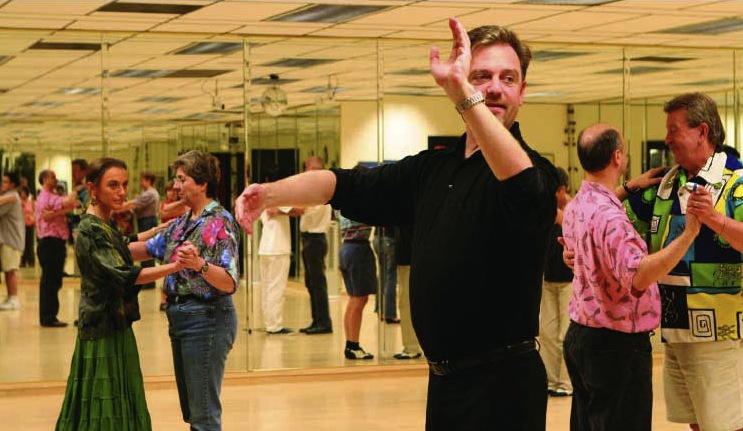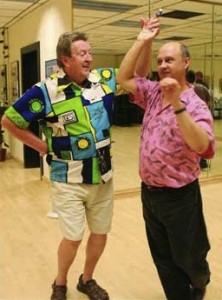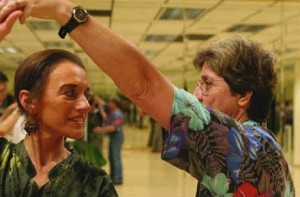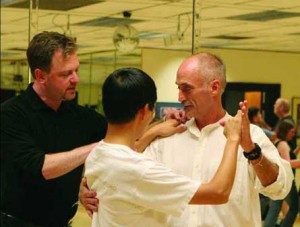Daniel Hutchison teaches Ballroom Dancing 101
by Rebecca Ragain of Just Out · Photos by Xilia Faye
“I’m uncoordinated. People are going to laugh at me. I’m going to step on my partner’s toes. I don’t have a partner.”
These are just a few of the excuses that people use to avoid social dancing. During 18 years of teaching dance, Daniel Hutchison has heard all these objections – and debunked them.
“When people are negative, I like to show them that they can do it,” says Hutchison, who has been offering ballroom dance instruction to the sexual minorities community for 11 years through his business, Out Dancing.

Through the years, dozens of would-be dancers have learned to fox-trot, waltz, cha-cha, tango and two-step their way around a dance floor under Hutchison’s tutelage. They go out dancing, and dance at home in their garages, living rooms and kitchens.
Many of his students credit their love of dancing to Hutchison’s skillful teaching, which helped transform them from cautious to confident.
Brian Arnzen is one of those students. When he and his partner started attending classes at Out Dancing three years ago, he remembers feeling nervous. He hadn’t danced much in the recent past, and what little dancing he had done was not formal ballroom style.
Not only was Arnzen out of practice, but he also felt clumsy. “Trust me, I have big feet. I could cause damage,” he says. But with Hutchison’s advice, Arnzen was able to avoid trodding on his partner’s toes. During classes, Hutchison points out that if one maintains the proper frame while dancing – holding the other person’s shoulders and arms correctly – your feet don’t get in the way.
“It’s easy,” says Arnzen. “I didn’t believe him at first, but it really does help to have that framework.”
Now the couple go out dancing about 10 times a month. They receive compliments on their moves, even though Arnzen insists they are “just people who like to dance a little.”
Whether square dancing with the Rosetown Ramblers or swinging to the Rose City Swing band, Arnzen keeps in mind what he learned during Hutchison’s classes: Dancing is supposed to be fun.
Arnzen says: “Now we feel comfortable going somewhere else and dancing, whereas before we’d have been like ‘Uh, we’re not going to try that.’ Even if it’s something we don’t know how to do, we’re much braver because [Hutchison] shows us…it’s about having a good time with other people.”
Ready To Rumba
At five minutes to 7 on a balmy Friday night in August, approximately 40 people are milling about Ankeny Street Studio waiting for Hutchison’s class to begin. It is the first Friday of the month, so a new session of classes is starting. Hutchison features a different style of dance each month; this month’s focus is the rumba.

The dancers range in age from early 20s to mid-50s, though Hutchison has had students in their 80s in the past. Some of tonight’s dancers are wearing what appear to be specialized dance shoes, whereas others sport Dr. Martens boots or sneakers. There are a number of couples attending, and there are also those who have signed up for the class on their own.
One man spots a guy he knows from somewhere else: “Hey, what are you doing here?” The two agree to partner up for the evening’s dance lesson.
Hutchison is making his way around the studio, looking dapper in black slacks, polished dance shoes and a black button-up shirt. His life and dance partner, David Wilson, is dressed more casually, in jeans and a plaid cotton shirt.
Though Hutchison teaches all the classes, Wilson pitches in by running the registration table and helping with other administrative tasks. During the lessons, he is Hutchison’s dance partner.
Hutchison believes it is easier for people to see how the dance should look when he has a skilled partner with whom to demonstrate. He says, “Instead of me showing what the follower does, and then me showing what the leader does, they can see the whole picture, how it works together.”
According to Hutchison, who has done both, there is not much difference between teaching a straight class and teaching one composed primarily of gays and lesbians. The one exception is the way the dance roles are described. Instead of saying the “man’s part” or the “woman’s part,” as is typical in straight classes, Hutchison says “lead” and “follow.”
The rumba class starts off with this division. Hutchison asks the lead dancers to go to one side of the room and the follows to the other side. When it becomes clear that there are more follows than leads in tonight’s group, some dancers switch sides. These talented ladies and gentlemen are able to dance either role.
Once they have gathered on their respective sides of the room, the leads and the follows pair up for the lesson. Unlike some ballroom dance classes, Hutchison does not ask the students to rotate partners throughout the evening, a fact that appeals to couples who want to learn to dance well together.
The class begins in earnest with a basic rumba step. For this Latin dance, Hutchison explains, everyone’s feet should be a little “ducky,” with the toes farther apart than the heels.
Creative and easy-to-understand descriptions such as this are Hutchison’s trademark. For instance, he describes the hip motion of the rumba as “Elvis is rotating his pelvis” and moves his hips in exaggerated figures to demonstrate.
After practicing the basic step for several minutes, the class moves on to another position. In this pattern, dancers swivel the balls of their feet on the ground a bit with each step. “Exactly like squishing cockroaches,” says Hutchison. “There are four dead cockroaches to this pattern. We want to make sure the cockroach is dead, so we start with the biggest toe and move to the smallest.”
The students repeat the cockroach step several times without music. Eventually, Hutchison walks over to the stereo and pushes play. It is not all Latin music that he plays, as one might expect in a rumba class. The mix includes songs by Elvis, Bette Midler and Madonna.
“Daniel tries to make the music more modern so if people are at a club they can still dance,” says Wilson.
The couples continue to practice the new steps. Some are smiling and giggling, and others have serious, contemplative expressions on their faces.
Hutchison walks purposefully through the room, adjusting an elbow here or repositioning a hand there.
Before long, it is 8 p.m. Most of the dancers smile, say goodnight and drift out of the studio toward whatever the rest of their Friday night holds.
For Jeff Knapp and Mark Clift, who have been taking Out Dancing classes for nearly six years, it has become part of their Friday ritual. Knapp says: “We feel like we’ve done something productive but also fun. It gets the weekend off to a good start.”
Dakota InyoSwan usually comes to class with friends. From there, the group goes out for a drink or indulges in dessert. “It’s been a really fun social venue, in addition to the dancing,” says InyoSwan.
Beyond The Basics
A few students stay in the studio for the Level Two class at 8 p.m., which is a continuation of the previous month’s Level One class. This month, for instance, Level Two dancers are polishing their new rumba moves.
Some find it difficult to transition from one style of dance at 7 o’clock to a different style at 8. Instead, they prefer to focus on one dance at a time, says Hutchison. But even without attending a Level Two class, there is always something new to learn, because the featured dance style changes from month to month.
Even when year-round regulars do end up repeating Level One classes–which is bound to happen, because return students make up 50 percent of an average class–they find that they still learn something new.
Just because people have taken a class once doesn’t mean they have mastered every step, reminds Hutchison, who still seeks out advanced coaching lessons whenever he can. In fact, it might take six different explanations before a particular pattern or step finally clicks.
“What I’ve found through the years…is that each time you listen to somebody explain a principle in dancing you’ll hear a different segment, or you’ll hear it differently, or understand it differently,” says Hutchison.
And sometimes, as Knapp admits, you just need a refresher: “Our memories are extremely short. Every time we do a dance we’re like: ‘Oh, this is new. Have we done this before?’ Even if it’s our fourth time on tango.”
Even for those with excellent memories, Hutchison finds a way to make it more interesting to repeat Level One classes. Although he might teach the same style of dance more than once during the course of a year, he rarely teaches it in exactly the same way.
Hutchison explains how he keeps repeat classes from becoming boring: “Obviously the basics are The Basics, and I have to fit those in. But there are so many variations in every single dance that I can pick certain variations to make that class unique.”
For those who want to improve their dance skills in a hurry, Hutchison also teaches private lessons at Ankeny Street Studio. People who sign up for these lessons are frequently preparing for a commitment ceremony or wedding, he says, either their own or someone else’s.
Casey and Berdell Moffett-Chaney took private lessons from Hutchison before their wedding. “Daniel is an exceptional teacher,” says Berdell. “If you want to really increase your level of dancing, take lessons.”
The couple’s dream was to perform a Viennese waltz to celebrate their wedding. Working with Hutchison, they choreographed a dance and fine-tuned the steps. On days when they weren’t taking lessons, they practiced at a nearby mall, where everyone applauded their efforts.
So with Hutchison’s help, the Moffett-Chaneys lived their dream. They decided to hold their reception at Ankeny Street Studio, where they had plenty of room to waltz.”So many people from Daniel’s classes were there,” recalls Casey. “The whole place was dancing!”
Gail Davis and Janyce Bender didn’t start taking classes from Hutchison to intentionally prepare for their wedding. Nonetheless, the two fondly remember a time during their honeymoon–eight months after they first went to Out Dancing–when they danced the tango together.
“It was the highlight of our honeymoon, and we weren’t speaking a word,” Davis says.
Eleven Years and Counting
Hutchison had been teaching dance for six or seven years when a friend approached him with the idea of starting a dance class specifically for gays and lesbians. Hutchison liked the idea right away.
“I wanted to have more gay people and friends who could dance, because I enjoyed dancing so much. It just seemed like the right thing to do,” recalls Hutchison.
At the time, Out Dancing was the only dance class in Portland dedicated to same-sex couples, or at least the only one of which Hutchison was aware.
At first, he says, there were more gentlemen in the classes than women. Over time, the balance has shifted slightly; there are now more lesbians in most sessions. The classes are open to anyone, however. Straight students also attend on occasion, often referred by or accompanying their friends from the queer community.

When the Moffett-Chaneys started taking dance classes about six years ago, they attended straight lessons first. They tried four or five teachers but were still feeling dissatisfied with the level of teaching they were receiving. When someone mentioned Hutchison’s name, they decided to give his classes a chance.
“We had no idea it was a gay dance group,” says Casey. “We went to the first class, and my jaw dropped.” Berdell adds: “We were hooked the first time. His way of teaching is…very effective. You don’t feel embarrassed, you don’t feel scolded.”
Attendance at Out Dancing continued to grow through the years, as previous students returned again and again, and new students found out about the class.
In 2001, Hutchison added a new component: a dance social on the second Saturday of every month. His thinking was that although many of his students had been taking classes for years, there wasn’t necessarily anywhere for them to go out dancing.
“You can do some of the dances at a smoky bar, to the pounding bomp-bomp music that they play, but there are some dances that you can’t do,” says Hutchison.
So he decided to create a venue for them to enjoy each other’s company and, of course, to dance.
At the socials, Hutchison plays a variety of music so couples can dance any number of styles throughout the evening. Light refreshments such as bottled water and cookies are included in the price of admission. Hutchison even decorates the studio.
When dancers get tired, they can sit out a song or two at the small tables that line the walls, or just stop and chat.
“The socials are where you really get to talk to people,” says Casey Moffett-Chaney. “You come in and meet people. ‘OK, now we’ve taken classes together for the last four months. What’s your name?'”
Davis says the social “has become really important, something exciting that we look forward to every month.” For $8 at the door, it’s a steal of a Saturday night.
A Talented Tutor
Hutchison credits some of his class’s popularity to a recent increase in media coverage of ballroom dancing. In 2004 and 2005, television shows such as Dancing with the Stars and So You Think You Can Dance began to air. Last year’s hit documentary Mad Hot Ballroom only added to the frenzy.
“It’s been more on the public radar,” summarizes Hutchison.
His students cite other reasons for their dedication to Out Dancing, mainly the instructor’s style. Arnzen says Hutchison brings a “really nice energy” to his teaching. Others tend to repeat the words “patient” and “kind” when talking about him.
Out Dancing’s teacher is also known for his ability to keep the mood light and to maintain a sense of humor about the learning process. “No one has fallen over or started crying, so we’re having some measurable success,” he called out during the first rumba class in August.
During 14 years of recreational dancing, InyoSwan has attended many different classes in a variety of places. For her, Hutchison stands out from the rest: “He’s a really great instructor. He treats everybody with real respect and kindness, whatever your level is.”
Knapp appreciates the fact that whenever he gets frustrated, Hutchison comes up with a “hint or trick” to help him overcome the block.
For Hutchison, when a student makes a breakthrough like that, it is one of the biggest joys of teaching. “It’s fun to take somebody on that road of discovery…to help somebody find that they have this hiding inside of them and didn’t know it,” he says.
Not Just a Class, It’s a Community
No matter how highly respected Hutchison is as a teacher, Out Dancing has become more than series of dance classes. He has created a safe, healthy environment where same-sex couples can learn to dance together, where gays and lesbians can interact, where singles can meet other people.
“One of the things that Daniel provides is a dif-ferent niche for people to get together. It’s a really positive outlet for the community, very inclusive,” says Arnzen.

Davis agrees, calling Out Dancing a “completely unique service” for same-sex couples. She says she can’t think of many other dance venues that offer a nonsmoking setting, free of alcohol. And there are still fewer places that draw such a compatible group of people. Davis maintains that anyone could walk into an Out Dancing event and feel comfortable.
Knapp says: “It’s an atmosphere where you feel like you can get to know people. It’s not about drinking or smoking, it’s just this pleasant atmosphere, very low-key.”
Arnzen, too, likes spending time at Ankeny Street Studio because it is a smoke-free space. “I hate to go out and bury my clothes in the back yard,” he jokes.
The group that gathers at Out Dancing is accepting of all levels of dancers. Even those with only the most basic skills can still have a good time, says Knapp.
“People don’t judge other people’s abilities,” he says. “Everyone just goes and has fun. It doesn’t matter if you beginner or someone who has gone for five, six or 10 years.”
“It’s not an environment where if you’re not good, someone is going to kick you off the dance floor. We were all there once,” seconds InyoSwan.
She adds: “It’s a place to enjoy each other and the freedom to dance with partners, sweethearts and friends. We get to express who we are.”
For more information about OUT DANCING call 503-236-5129 or visit www.outdancing.info.
Portland freelance writer REBECCA RAGAIN enjoyed squishing imaginary cockroaches during Out Dancing’s rumba lesson. She can be reached at rebeccaragain@yahoo.com.